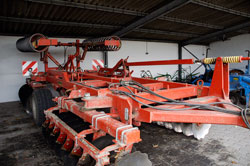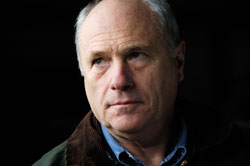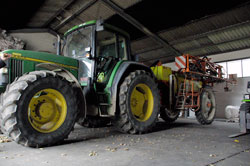 It’s certainly no surprise that crops are cultivated in Germany, but some of the country’s farms, equipment and practices held a few surprises. Both the German Agricultural Society and John Deere hosted a visit to the BASF Gutsbetrieb Rehhütte, or the BASF Deer’s Den Farm, in Limburgerhof, Germany left a couple reporters from our group incredulous at how clean a farm could be. Stone tiles paved a courtyard of sorts between equipment garages, sheds and farms silos. Some not-so-familiar looking equipment also prompted some curiously raised eyebrows. Though, I must admit, we all recognized the three John Deere tractors in Albert’s shed and he was very excited to show them off. The history of the farm was also an attribute that’s rather atypical for an American farm. The Limfburg Estate was first documented in 1035. BASF took over the land and began farming it in 1899.
It’s certainly no surprise that crops are cultivated in Germany, but some of the country’s farms, equipment and practices held a few surprises. Both the German Agricultural Society and John Deere hosted a visit to the BASF Gutsbetrieb Rehhütte, or the BASF Deer’s Den Farm, in Limburgerhof, Germany left a couple reporters from our group incredulous at how clean a farm could be. Stone tiles paved a courtyard of sorts between equipment garages, sheds and farms silos. Some not-so-familiar looking equipment also prompted some curiously raised eyebrows. Though, I must admit, we all recognized the three John Deere tractors in Albert’s shed and he was very excited to show them off. The history of the farm was also an attribute that’s rather atypical for an American farm. The Limfburg Estate was first documented in 1035. BASF took over the land and began farming it in 1899.
 There are about 1250 acres on the BASF farm, which employs about 32,000 people. Farms are subsidized in Germany, and Farm Manager Albert Woll says the region benefits from subsidies because, without farms, the area would be covered in sand dunes. The BASF farm uses about 750 acres for wheat with an average yield of about 312 bushels or 8 ½ tons. Albert says the farm’s objective is to cultivate the highest quality of wheat and, right now, winter wheat goes for 260 euro a ton.
There are about 1250 acres on the BASF farm, which employs about 32,000 people. Farms are subsidized in Germany, and Farm Manager Albert Woll says the region benefits from subsidies because, without farms, the area would be covered in sand dunes. The BASF farm uses about 750 acres for wheat with an average yield of about 312 bushels or 8 ½ tons. Albert says the farm’s objective is to cultivate the highest quality of wheat and, right now, winter wheat goes for 260 euro a ton.
The BASF farm uses about 150 acres for sugar beet, with an average yield of about 2800 bushels. Albert says sugar beet used to offer a strong income for German farmers, but the recent surge in demand for sugarcane in 3rd world countries have hurt the sugar beet factories in his country. He says sugar beet factories are closing down, including one just south of Limburgerhof. Albert says there are still about 17 sugar beet factories in Germany, but there used to be 3 times as much. He says farmers have to travel up to 2000 km to sell their sugar beet. Sugar beet is the only crop in Germany with a government contingency. Farmers are free to grow any amount of any other crop. But, he says farmers have to be prudent about choosing crops they can irrigate.
 The Old Rhein, a river that winds through that part of the region, supplements the BASF farm with water needed for irrigation. Albert says the old Rhein basins maintain steady levels except in the early spring when demand for water is high. He says the basins help offset the decrease in annual rain precipitation, which has dipped to 540 mm from 640 mm. The last few months in Germany have been particularly dry with just 8 mm of rain in September, 4 mm in October and next to nothing so far for the month of November.
The Old Rhein, a river that winds through that part of the region, supplements the BASF farm with water needed for irrigation. Albert says the old Rhein basins maintain steady levels except in the early spring when demand for water is high. He says the basins help offset the decrease in annual rain precipitation, which has dipped to 540 mm from 640 mm. The last few months in Germany have been particularly dry with just 8 mm of rain in September, 4 mm in October and next to nothing so far for the month of November.
Corn is another big crop for the BASF farm, though farmers are reducing the acres they dedicate to their corn crop because of price pressure. Albert says he used about 900 acres of the BASF land this year for corn. Unlike the U.S., he says Germany is not really growing corn for use in developing ethanol.
The BASF farm uses about 150 acres for research. Speaking of research, Albert did test out the use of biodiesel with farm equipment. He says he used an 85 percent blend of bio-diesel, but found his equipment ran poorly on the bio blend.
